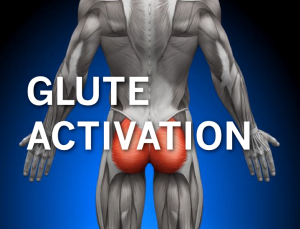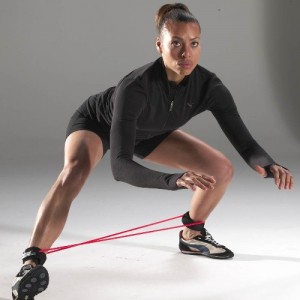By Eric Martinez CSCS. When the phrase “Glute Activation” stumbles upon us, what does it exactly mean? Well, before I  start rambling on please do me a favor and sit up straight and have your booties nice and relaxed. Glute Activation is another way of saying warming up your buns or stretching the muscles in your buns. The famous muscle “Gluteus Maximus,” oh where would our bodies be without this beautiful muscle, aka our butt? Well, our glutes only pretty much help and act as stabilizers for our legs and torso, that’s pretty damn important if you really stop and think about it. The butt, which most of us treat like a vestigial bleacher cushion, isn’t just the main engine of the lower body; it’s also the steering wheel. Underneath and around the gluteus maximus is a critical network of smaller muscles: the gluteus medius (top), the gluteus minimus (lower) and a group of thinner muscles known as the deep six. Together, they surround the femur and pelvis like a rubber-band ball. And, ladies and gents when we activate these muscles properly and put them to work in the weight room, my oh my what a beauty it can become along with numerous reaping benefits to your health, daily training routine, and overall eye candy.
start rambling on please do me a favor and sit up straight and have your booties nice and relaxed. Glute Activation is another way of saying warming up your buns or stretching the muscles in your buns. The famous muscle “Gluteus Maximus,” oh where would our bodies be without this beautiful muscle, aka our butt? Well, our glutes only pretty much help and act as stabilizers for our legs and torso, that’s pretty damn important if you really stop and think about it. The butt, which most of us treat like a vestigial bleacher cushion, isn’t just the main engine of the lower body; it’s also the steering wheel. Underneath and around the gluteus maximus is a critical network of smaller muscles: the gluteus medius (top), the gluteus minimus (lower) and a group of thinner muscles known as the deep six. Together, they surround the femur and pelvis like a rubber-band ball. And, ladies and gents when we activate these muscles properly and put them to work in the weight room, my oh my what a beauty it can become along with numerous reaping benefits to your health, daily training routine, and overall eye candy.
(Check out ‘Monster Walks’ for activating the Glutes!).
I hope everyone is still sitting up straight with their booties relaxed. So, how do we activate this star studded muscle? Well, this is where the two exercises “Monster Walks” and “Sumo Walks” are introduced. You might be thinking, huh? What the hell are those? These two exercises are commonly employed in Strength and Conditioning and will become more popular as time goes on. There was a study done in the Journal of Clinical Biomechanics by Cambridge et al, Sidorkewicz, Ikeda, and McGill 2012 on the effects of resistance band placement on gluteal activation during two common exercises. The researchers wanted to understand the effect of resistance bands on muscle activation profiles during two rehabilitation exercises, called “Monster Walks” and “Sumo Walks.” These exercises involve walking in semi-squat postures in order to involve the gluteal muscles and the tensor fascia latae (TFL). So, they recruited 9 male subjects and had them perform both these exercises to see what area gave more glute activation with three different band placements: above the knee, ankles, and forefeet.
The researcher’s findings were very similar for both the “Sumo Walks” and “Monster Walks”. By decreasing band height, the activation of Gluteus Medius (top) and Tensor Fascia Latae  (TFL) were found to increase progressively. The increase from the knee to ankle for the Gluteus Medius didn’t reach much significance. The Gluteus Maximus activation was low and only increased significantly when the resistance bands were moved to the forefoot. Which is very interesting because our first instinct when trying to activate our glute muscles would not be to put resistance bands on our feet? So, what did the researchers conclude in their study? They concluded that band placements that were more distal (further from the center of the body) caused the gluteal muscles to be highly more activated than any other placement. We now know that when performing these two exercises prior to a training session that by using band placement at the forefeet will lead to greater gluteal activation, without increasing involvement of the TFL.
(TFL) were found to increase progressively. The increase from the knee to ankle for the Gluteus Medius didn’t reach much significance. The Gluteus Maximus activation was low and only increased significantly when the resistance bands were moved to the forefoot. Which is very interesting because our first instinct when trying to activate our glute muscles would not be to put resistance bands on our feet? So, what did the researchers conclude in their study? They concluded that band placements that were more distal (further from the center of the body) caused the gluteal muscles to be highly more activated than any other placement. We now know that when performing these two exercises prior to a training session that by using band placement at the forefeet will lead to greater gluteal activation, without increasing involvement of the TFL.
Time to wrap up this glute activation talk ladies and gentlemen. I can’t tell you how many people I see walk into the gym and go straight to the squat rack or straight to deadlifting without any kind of warm up or gluteal activation exercises. It is mind boggling and to this day I still can’t understand why people do it. It’s is imperative that we take 15-20 minutes to properly warm our bodies up and activate our glute muscles, remember they are the steering wheel to your lower body and they deserve to be activated. Keeping this muscle healthy, strong, active, and full ROM (range of motion) is key for a successful training protocol overall, not just for your lower body, but for your upper body and for the long run most importantly. The last thing you want to do is sustain an injury in one of your glute muscles, just the thought of it sounds painful. The society we live in today is dominated by a sedentary lifestyle and although many people are active, at the end of the day you are probably sitting on your tush for 8 hours a day to pay the bills. So, take the time to try some Monster or Sumo walks and get your glutes activated and ready for battle. Remember, you always want that booty looking better going than coming.
References:
(1) Cambridge ED, Sidorkewicz N, Ikeda DM, McGill SM, Progressive hip rehabilitation: The effects of resistance band placement on gluteal activation during two common exercises, Clinical Biomechanics 2012
“No Excuses, Only Solutions”
BIO
We are Chris and Eric Martinez, the “Dynamic Duo” of Dynamic Duo Training. We are identical twins, born and raised in Santa Rosa, CA. We are Certified Personal Trainers through AFAA (Aerobics and Fitness Association of America) and CISSN (Certified International Society of Sports Nutrition). Fitness has always been central to our lives. We have pursued a love of sports since the fourth grade, with basketball and soccer being our focal sports. In high school, we faced the loss of our father, and it made a huge impact on us. We feel it was a trial that strengthened us, but it also formed our belief that nothing is more important than health for living a long, happy and fulfilling life. Since that time, having an optimally functioning body has been a priority in our lives, which we have pursued through our study and practice of fitness and nutrition. It is a passion we wish to share with others, which is why we started Dynamic Duo Training. Go to: http://www.dynamicduotraining.com/aboutUs.htm



